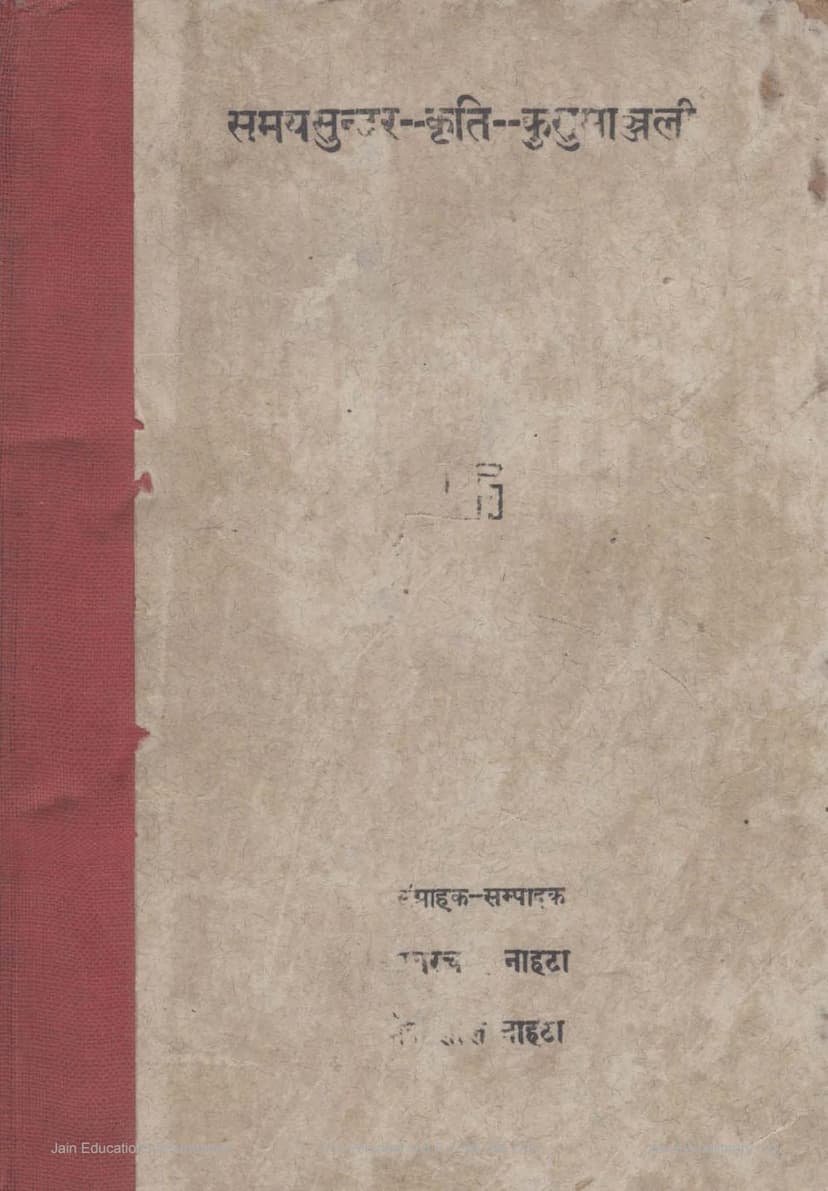Samaysundar Kruti Kusumanjali
Added to library: September 2, 2025

Summary
This is a comprehensive summary of the Jain text "Samaysundar Kruti Kusumanjali" based on the provided pages:
Book Title: Samaysundar Kruti Kusumanjali Compiler/Editor: Agarchand Nahta, Bhanvarlal Nahta Publisher: Nahta Brothers, Calcutta Published: Chaitra Shukla 13, V.S. 2013 / V.S. 2482 Edition: First Edition Value: ₹ 20.00
Overview: "Samaysundar Kruti Kusumanjali" is a collection of 563 short compositions by the renowned Jain poet, Kavi Samaysundar. This book serves as a significant compilation and publication of his lesser-known works, brought to light through the dedicated research and efforts of the Nahta brothers.
Key Figures and Contributions:
- Kavi Samaysundar: The central figure, celebrated as a prolific and influential Jain poet of the 17th century. He is recognized for his deep understanding of Jain philosophy, his mastery of various literary forms, and his ability to convey profound spiritual and ethical messages through accessible language. His compositions cover a wide range of subjects, including devotion, inspiration, moral teachings, historical events, and philosophical insights.
- Agarchand Nahta and Bhanvarlal Nahta: The compilers and editors of this volume. They are lauded for their extensive research, dedication to uncovering and preserving forgotten Jain literature, and their commitment to making these valuable works accessible to the public. Agarchand Nahta is particularly highlighted for his role as a "restorer" of ancient texts rather than just an explorer, effectively presenting their historical and cultural significance.
- Dr. Hazariprasad Dwivedi: The author of the foreword. He praises Agarchand Nahta's scholarly contributions, emphasizing his role in bringing forgotten authors and texts to light and making them accessible through meticulous editing. Dr. Dwivedi notes the immense value of Samaysundar's work for studying the language, style, and historical context of 16th and 17th-century Braj and Gujarati languages.
- Mahopadhyay Vinaysagar: The character writer and researcher. His detailed biographical account of Kavi Samaysundar is included in the book, offering insights into the poet's life, intellectual prowess, and his lineage within the Kharatar Gachchha tradition.
- Late Shri Mohanlal Dalichand Desai: The book is dedicated to his memory. He is recognized as a "Jain Literature Maharathi" whose work, particularly his essay "Kavivar Samaysundar," was instrumental in inspiring the Nahta brothers to pursue this collection. Desai's own extensive research on Jain poets and history is acknowledged as a foundational contribution.
Content and Significance:
- Collection of Short Compositions: The book comprises 563 distinct works by Samaysundar, encompassing a variety of forms such as ras, chaupais, stanzas, songs, and devotional pieces (stavan).
- Historical and Cultural Importance: The foreword and character sketches highlight the significance of these works for understanding the socio-cultural landscape, linguistic evolution, and religious practices of the 17th century in India, particularly in Rajasthan and Gujarat.
- Vivid Descriptions: The collection is noted for its inclusion of a vivid description of a famine in 1687 CE, offering a poignant glimpse into the hardships of that period.
- Linguistic and Stylistic Study: The works are valuable for studying the prevailing styles of recitation, language (including Braj and Gujarati), and poetic expression of the era. Samaysundar's ability to seamlessly blend spiritual themes with artistic expression is emphasized.
- Inspiration and Motivation for Research: The book details how the pursuit of Samaysundar's compositions led the Nahta brothers to interact with other prominent scholars like Mohanlal Desai, P. Lalchand Bhagwandas Gandhi, and Purnachandra Nahar, thus fostering a network of Jain literary research.
- Diverse Themes: The collected works explore themes of devotion, inspiration, moral instruction, philosophical contemplation, and historical accounts. The devotional poetry is noted for its emotional depth and heartfelt expressions of faith.
- Author's Dedication and Effort: The extensive compilation process, spanning years of searching through various libraries and collections, underscores the dedication of the editors. They meticulously gathered scattered pieces, even from fragmented manuscripts, to create this comprehensive volume.
- Literary Merit: Samaysundar's poetry is praised for its expressive power, vast knowledge base, and the ability to handle diverse subjects with ease. The book also helps in understanding contemporary musical traditions and song styles.
- Errata: The publishers acknowledge that despite their best efforts, some textual errors or omissions might exist in the printed volume due to the nature of collecting from manuscript sources. They provide a list of these errors for potential correction by readers.
- Categorization of Works: The extensive index (Anukramanika) demonstrates the meticulous effort in cataloging the hundreds of compositions by type, theme, and order, revealing the sheer breadth of Samaysundar's literary output.
In essence, "Samaysundar Kruti Kusumanjali" is a monumental work that resurrects and presents the rich literary legacy of Kavi Samaysundar, making it a vital resource for scholars of Jain literature, history, and culture.